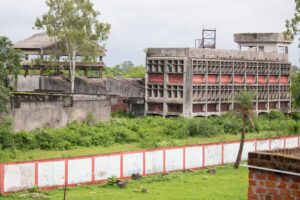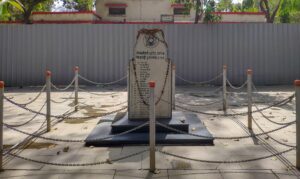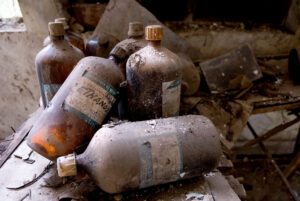In 1984, a chemical leak at a pesticides factory in Bhopal, India, would – according to some estimates – claim over 25,000 lives. Journalist Catherine Early looks back at the world’s works industrial disaster and asks if its impact has really been felt?
Justin Lobo remembers the night of 2 December, 1984, when he was just four years old. “It was just after midnight when our parents woke us up. We could feel our eyes burning and our throats were itchy.
“There were hundreds and hundreds of people running and screaming on the streets outside, only half dressed because they did not have time. Everyone was scared, we didn’t know what was happening but someone said there had been a chemical leak,” he recalls.
The cause of the mass panic was a gas leak from the Union Carbide pesticides factory. A defective tank at the Union Carbide factory in Bhopal had leaked 27 tonnes of deadly methyl isocyanate gas into the air, leaving people gasping for breath and foaming at the mouth.
The gas cloud spread over the city, exposing half a million people to toxic fumes. The Lobo family was relatively lucky, as their home was in New Bhopal, further away from the pesticide plant from where the gas leak had originated. Those in nearer Old Bhopal were the most severely affected. By morning, thousands were dead.

The remains of the plant in Bhopal, which still stands today ©Alamy
The Union Carbide factory had been built in 1969 to produce the pesticide Sevin. A methyl isocyanate (MIC) production plant was added to the factory in 1979, with three underground storage tanks holding 68,000 litres of the chemical.
Used as an intermediate in pesticide manufacture, MIC is extremely toxic to humans when inhaled or ingested. Exposure to even small quantities causes chest pain, coughing, asthma and irritation to the eyes, nose and throat. Higher quantities can cause pulmonary lung edema, haemorrhages, bronchial pneumonia, and death.
“The specific cause of the leak has actually not been determined, there’s four competing theories as to what actually happened. I don’t have an opinion on which is the truth, because there were so many things that went wrong, any of them could be plausible and none of them change the outcome,” explains Trish Kerin, director of the IChemE Safety Centre.
The plant was of a standard design used by Union Carbide in other parts of the world, which specified materials for all the equipment, including configurations that should be used for safety purposes. But these requirements were not followed in construction, Kerin says. For example, the equipment holding the MIC should have been stainless steel, but carbon steel had been used instead, leading to corrosion and leaks, and the pump seals were ceramic instead of metal. In fact, prior to the major leak on the 2 December, there had already been a smaller leak that killed a worker, and another incident that led to the hospitalisation of 25 workers, and complaints about the lack of safety by others.
Indian journalist Rajkumar Keswani was friends with the worker who died, which alerted him to the problems at the site. During his investigations, he found unpublished audits by safety inspectors sent by Union Carbide in the US in 1982. They reported major lapses at the plant, including the potential for material to leak from storage tanks, runaway reactions and multiple failing safety valves and instruments. They detailed 61 hazards, 30 of which were critical, and 11 in the MIC units. However, Keswani’s stories were ignored by the public and the authorities.
The gas leak was caused by a runaway reaction that occurred within one of the storage tanks, forcing MIC gas out over the city, Kerin says. “The bit that’s under dispute is why the reaction took place in the tank – there was some contaminant or water in the tank, but no-one quite knows how that got there,” she says.
Ongoing impacts
The official death toll for the Bhopal disaster stands at 5,295. But in addition to those who died in the immediate aftermath of the leak, many more experienced serious health conditions as a result of gas exposure and contamination of the local water supply.
Problems with respiratory and nervous systems are particularly common, but cancers, joint pain, fatigue, obesity caused by hyperthyroidism, and mental illnesses are also common complaints. Female victims have had problems conceiving, and have given birth to children with growth retardation.
Survivor campaign groups estimate that total deaths over the years at more than 25,000, with 8-10,000 of those in the first three days alone. The number of people suffering permanent disability or chronic health problems has been estimated at 100,000.
The Sambhavna Trust Clinic was set up specifically to treat the victims of the disaster. It currently has around 36,000 patients registered for chronic care, according to its managing trustee Satinath Sarangi.
Victims were granted 25,000 rupees ($300) in compensation by Union Carbide, via a $470 million payout to the Indian Government in 1989. The disaster led to the collapse of Union Carbide, which was bought by Dow Chemical in 2001, none of its US management were ever held liable, though those in senior management roles at Union Carbide India Limited, which designed and operated the plant, were found guilty of negligence, according to Union Carbide.
The Bhopal plant was closed, but was never fully decommissioned, and still stands today, though responsibility for its remediation passed to the Madhya Pradesh State Government, according to Bhopal.com, a website set up by Union Carbide to put across its side of the story.

A victim memorial at Bhopal Railway Station ©Alamy
Campaign groups are still fighting for justice. Many are angry with the Indian government for downplaying the number of deaths, and the extent of illnesses still suffered by survivors, Sarangi says. This has been the case no matter which political party has been in power since the disaster, as all have received financial donations from Union Carbide, or Dow Chemicals, which also has significant clout with the US government, he says.
The difference in the death toll is because of the government’s “arbitrary and unilateral” decision to only register deaths that have occurred up to 1997, according to Sarangi. “Deaths attributable to exposure do not stop in a certain year, just like that, but that’s what they have decided,” he said. A legal case to demand additional compensation is underway in Indian courts.
Sarangi blames the ongoing justice on the fact that more than half the survivors of the disaster are Muslim, while around 80% of the rest are low caste. Both of these groups are treated as second class citizens in India. “It’s a very stewed-up situation, because on the other side, you have two very powerful corporations and the support of the US government,” he says.
In addition, the plant is situated in the low-lying area of Bhopal, where poorer people live. Many had moved there as agricultural work dried up with the development of intensive and mechanised farming as a result of the Green Revolution in the 1960s, he says. “I’ve been to several countries, and without exception I’ve seen that wherever there is a hazardous situation, that is where the poorest people live,” he says.
Global reaction
Despite the ongoing legal battles, the disaster did result in other, more positive changes. It proved a decisive moment for attitudes to safety, according to Kerin. “It raised in raised awareness of safety like no other incident had done before it,” she says.
“There was just absolute horror around the world by the sector that this could happen,” she says. “It was an enormous wake-up call.” There had been industrial disasters before, such as the explosion of a chemical plant near Flixborough in Lincolnshire, which killed 28 and seriously injured 36 people on site. “But we’ve never seen thousands of civilians killed in an instant overnight as they slept. That was what completely shocked the world,” she says.
One development that came about as a direct result of Bhopal was the launch of the Center for Chemical Process Safety by the American Institute of Chemical Engineers, which aimed to raise safety standards. Another was the establishment of the Chemical Safety Board, also in the US. Though this did not formally begin operating for several years, the legislative change to form it was made after Bhopal, she says.
In addition, the disaster significantly raised awareness of the importance of inherently safer design principles, she says. This means that risk is either eliminated through design of the plant and operations, or if that cannot be done, the risk should be moderated, attenuated, substituted, minimised or simplified, she explains.
“Having MIC as part of the process is not applying inherently safer principles – it should have been eliminated or at least minimised because it was not a feedstock, nor was it a finished product. It was an intermediate that didn’t need to be stored,” she says. Instead, the plant could have run a continuous operation, generating it, and using it in the same process, she says.
“What you don’t have, can’t leak,” she says, quoting Trevor Kletz, the chemical engineer who introduced the concept of inherent safety. Kletz “Raising the awareness of the need to understand the hazards of the substances you have on site at a technical level, and making sure you can manage those substances safely, was really driven out of this particular incident,” she says.
There were also the elements of the plant’s design that did not end up being followed through in construction, such as the use of stainless steel rather than the carbon steel that was used, she adds.
There were also changes to the culture around industrial safety in India, according to Jayandran Mohan, a chartered member of the Institution of Health and Safety (IOSH) who specialises in petrochemical engineering. “In 1984, the awareness of safety was very poor in India. There was no proper communication about hazardous substances with the public, so people didn’t know what was happening in the factory, or why,” he says. It was not a lack of safety laws that led to the Bhopal disaster, but rather poor implementation and monitoring, he says. Though this has since improved, there are still gaps, he adds.
“In India, occupational safety and health laws are very clear and specific at the documentation level. But implementation on the work site and monitoring by the government authorities needs to be improved. More effective and strict enforcement actions need to be included in the current legal code,” he says.

Bottles of Ethanol lie amongst the debris of the factory ©Alamy
According to data collected by global union IndustriALL in 2021, at least 429 accidents occurred in Indian manufacturing industries, including chemical and pharmaceuticals, mining, and steel, in which more than 352 workers lost their lives and over 700 workers were injured.
In the first half of 2022, at least 78 industrial and mine accidents have been reported, killing at least 199 workers and injuring more than 348. Unions have complained that safety incidents are vastly underreported in the country, and information should be made more accessible.
Inadequate hazard identification process and risk assessment, lack of training especially for precarious workers, the inadequate number of health, safety and factory inspectors, absence of safety audits of industrial establishments, and government-sanctioned slackness in management’s commitment towards safety at workplaces, among other reasons, contribute to industrial incidents’ occurrence in the country, IndustriALL said.
Learning from lessons
It is almost 40 years since the Bhopal disaster. Are there still lessons the safety sector can take from it? “Yes there are, because we forget,” Kerin says.
“There are always lessons to be learned from historical incidents no matter how old they are,” she says. “In Bhopal, they made a lot of changes to the facility, without managing it, or understanding the hazards they were introducing. It’s always useful to remind people about management of change and making sure that that when changes are made, they are adequately assessed and sufficient controls implemented, using the idea of inherently safer design.
“Bhopal provides a very clear example of how to describe and explain to people what’s needed, and what can go wrong when inherently safer design isn’t implemented,” she says.
People should not get complacent and dismiss the mistakes as those of the past, Kerin says. She gives the example of the Beirut ammonium nitrate explosion in 2020. The blast was caused by ammonium nitrate being stored in a warehouse that had not been equipped for storage, she recalls. The product was put there initially after being seized from an arms dealer, but it should not have been left there as long as it was, she says.
“It was a different product, different context, a different industry. But fundamentally, when you strip it all away, it’s the same specific mistake we’re making. That’s just how we’ve applied that mistake that changes,” she says.
The Safety Conversation Podcast: Listen now!
The Safety Conversation with SHP (previously the Safety and Health Podcast) aims to bring you the latest news, insights and legislation updates in the form of interviews, discussions and panel debates from leading figures within the profession.
Find us on Apple Podcasts, Spotify and Google Podcasts, subscribe and join the conversation today!





Great article, well researched and i appreciate the sincere care of the author in capturing the human losses and its impact in order to prevent such incidents from occurring agian.
The article has been very well written and superb data gathering by the Author. I hope the HSE Professionals, Engineers, Industrial Entrepreneurs, Corporates, Government Agency will keep keen eye on HSE aspects to avoid such catastrophic incident to Human community as well as to Mother Earth & Eco system.
It just shows the lengths that some governments will go brush aside such a massive disaster, despite happening many years before, just should have been dealt with by now , that fact that not only human lives were lost but also a massive impact to the eco system for years after the incident occurred